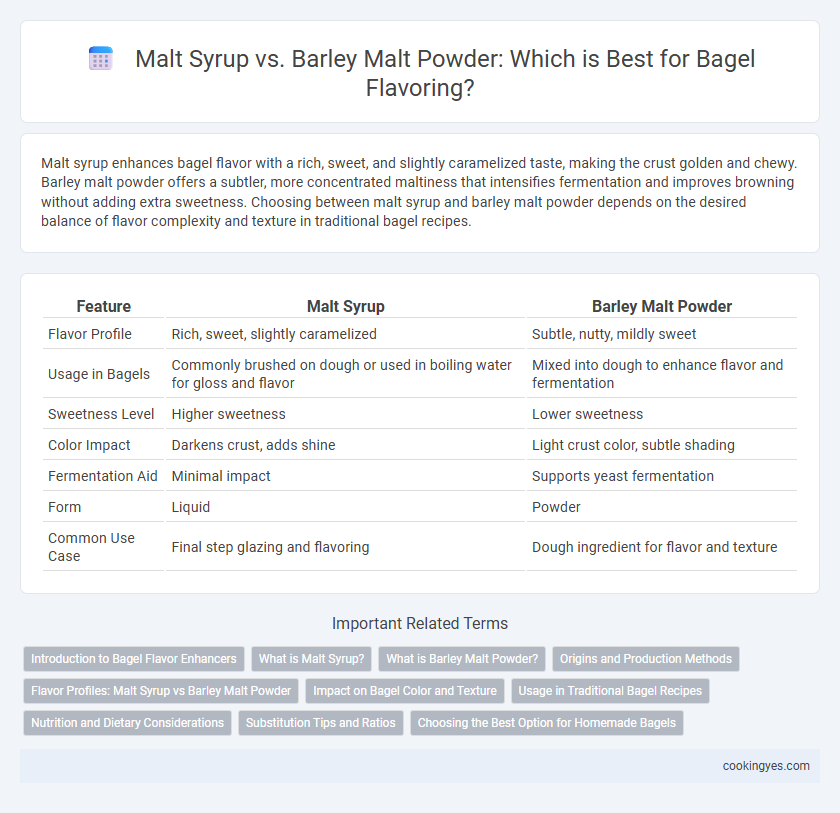Malt syrup enhances bagel flavor with a rich, sweet, and slightly caramelized taste, making the crust golden and chewy. Barley malt powder offers a subtler, more concentrated maltiness that intensifies fermentation and improves browning without adding extra sweetness. Choosing between malt syrup and barley malt powder depends on the desired balance of flavor complexity and texture in traditional bagel recipes.
Table of Comparison
| Feature | Malt Syrup | Barley Malt Powder |
|---|---|---|
| Flavor Profile | Rich, sweet, slightly caramelized | Subtle, nutty, mildly sweet |
| Usage in Bagels | Commonly brushed on dough or used in boiling water for gloss and flavor | Mixed into dough to enhance flavor and fermentation |
| Sweetness Level | Higher sweetness | Lower sweetness |
| Color Impact | Darkens crust, adds shine | Light crust color, subtle shading |
| Fermentation Aid | Minimal impact | Supports yeast fermentation |
| Form | Liquid | Powder |
| Common Use Case | Final step glazing and flavoring | Dough ingredient for flavor and texture |
Introduction to Bagel Flavor Enhancers
Malt syrup and barley malt powder are key flavor enhancers in bagel making, each contributing unique taste profiles and textures. Malt syrup, a thick, sweet liquid derived from malted barley, imparts a rich, caramelized flavor and promotes a glossy crust in bagels. Barley malt powder, a dry form of malt extract, provides a milder sweetness and enhances dough fermentation, resulting in a chewy interior and distinctive aroma.
What is Malt Syrup?
Malt syrup is a thick, sweet liquid derived from malted barley that is often used in bagel recipes to enhance flavor and improve crust color. It contains natural sugars that feed yeast, aiding fermentation and creating a chewy texture with a distinct malted sweetness. Unlike barley malt powder, malt syrup offers a more intense flavor and moisture contribution, making it a preferred choice in traditional bagel making.
What is Barley Malt Powder?
Barley malt powder is a natural sweetener derived from sprouted barley grains that have been dried and ground into a fine powder, commonly used in bagel recipes to enhance flavor and promote browning. Its enzymatic properties convert starches into sugars during baking, contributing to the characteristic chewy texture and rich, slightly sweet taste of traditional bagels. Unlike malt syrup, barley malt powder offers a concentrated malt flavor and a drier consistency, making it easier to incorporate into dough without adding excess moisture.
Origins and Production Methods
Malt syrup originates from barley grains that undergo a malting process involving soaking, germination, and kilning, resulting in a thick, sweet liquid used for bagel flavoring. Barley malt powder is produced by drying and grinding malted barley into a fine powdered form, preserving a concentrated malt flavor ideal for dough enhancement. Both ingredients derive from similar raw materials but differ in texture and moisture, affecting bagel crust and crumb characteristics subtly.
Flavor Profiles: Malt Syrup vs Barley Malt Powder
Malt syrup imparts a rich, caramel-like sweetness with subtle toasted notes that enhance bagel crust color and flavor depth. Barley malt powder offers a more concentrated, slightly nutty and malty flavor, creating a robust, complex taste in the bagel dough. Both ingredients contribute to the Maillard reaction, but malt syrup generally provides a softer, sweeter finish while barley malt powder yields a stronger, more pronounced malt character.
Impact on Bagel Color and Texture
Malt syrup imparts a rich, darker color and a slightly chewy texture to bagels due to its moisture content and caramelization during baking. Barley malt powder contributes a subtler brown hue and a crispier crust, enhancing the bagel's crunch without adding moisture. Both forms influence Maillard reactions differently, with syrup favoring softness and deeper color, while powder promotes a firmer bite and lighter browning.
Usage in Traditional Bagel Recipes
Malt syrup is commonly used in traditional bagel recipes to enhance crust color and impart a subtle sweetness, aiding in yeast fermentation and creating the characteristic chewiness of authentic bagels. Barley malt powder serves a similar purpose but is often preferred for its ease of measurement and consistent flavor profile. Both malt syrup and barley malt powder play crucial roles in achieving the distinctive flavor and texture associated with classic New York-style bagels.
Nutrition and Dietary Considerations
Malt syrup offers a rich source of natural sugars and minerals like calcium and potassium, enhancing bagel flavor with a subtle sweetness while providing trace nutrients. Barley malt powder contains enzymes that improve dough fermentation and contributes dietary fiber, beneficial for digestive health. Both options are gluten-containing, making them unsuitable for gluten-free diets, but malt syrup generally has higher sugar content impacting caloric intake.
Substitution Tips and Ratios
Malt syrup and barley malt powder both enhance bagel flavor by adding sweetness and a subtle malt character, yet their form and concentration require precise substitution adjustments. When replacing malt syrup with barley malt powder, use approximately 1 tablespoon of powder per 2 tablespoons of syrup to maintain the desired sweetness and color intensity. For optimal results, dissolve barley malt powder in warm water before mixing into dough, ensuring even distribution and consistent bagel texture.
Choosing the Best Option for Homemade Bagels
Malt syrup offers a rich, sweet flavor and enhances the crust's color, making it a popular choice for authentic homemade bagels. Barley malt powder provides a subtler, more concentrated malt taste and is easier to measure accurately, ideal for bakers seeking precision. Selecting between malt syrup and barley malt powder depends on desired flavor intensity and convenience in the bagel-making process.
Malt syrup vs barley malt powder for bagel flavoring Infographic

 cookingyes.com
cookingyes.com